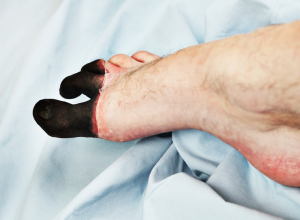
Frostbite
Frostbite is an injury that occurs when your skin and underlying skin tissue become too cold and start to freeze. It can happen to exposed skin as well as skin protected by gloves, socks and other clothing. The most common body parts that experience frostbite are the fingers, toes, ears, nose and chin.
In cold conditions, your body focuses on staying alive. Doing so entails limiting blood flow to the extremities (arms, legs, ears, nose, etc) in order to keep vital organs like the heart and lungs warm and functioning. When the chill continues, the body tries to thwart off hypothermia (a condition in which your body loses heat quicker than it can produce heat) by completely restricting blood flow to those cold extremities. This is when frostbite sets in.
Symptoms
Frostbite occurs in three stages: frostnip, superficial frostbite and severe (deep) frostbite. Each has its own symptoms.
Frostnip
The first stage of frostbite is called frostnip. If treated in this stage, frostnip does not lead to permanent skin damage. Symptoms include:
- Pale or very red skin that feels cold
- Prickling and/or numbness of the affected area (parasthesias)
- Pain and tingling when the skin is warmed
- Possible long term insensitivity to heat and cold
If you experience any of these symptoms, it is important that you warm the affected area right away to prevent skin and tissue damage. Untreated frostnip can progress to full on frostbite and lead to the loss of fingers, toes and other body parts.
Superficial Frostbite
The second stage of frostbite is superficial frostbite. Symptoms include:
- Reddened skin that turns pale, white, bluish or grayish
- The formation of ice crystals on the skin
- A warm feeling of the skin
- Loss of sensation from pain and cold, which may become a long term problem
If the skin is warmed at this stage, you may experience stinging, swelling and a burning sensation. Additionally, the skin may appear blue or purple, and blisters may appear within 24 to 36 hours. Frostbite at this stage requires immediate medical attention to avoid further skin, tissue, muscle and bone damage. With treatment, second degree frostbite usually heals in about a month.
*Note: Due to skin numbness and loss of sensation, you may not realize you have frostbite on your own.
Severe (Deep) Frostbite
The third stage of frostbite is called severe or deep frostbite. At this stage, all of the layers of skin — including the underlying tissue — is affected. Symptoms include:
- Numbness
- Complete loss of sensation from pain and cold, which may be permanent
- Hard or waxy skin
- Loss of muscle and/or joint function
- Fever
- Blisters that appear 24 to 48 hours after rewarming
If frostbite progresses to this stage, the skin and tissue begin to die, which causes it to turn black and harden. Severe frostbite requires immediate medical attention to avoid further skin, tissue, muscle and bone damage, as well as infections and nerve damage. Sometimes amputation is necessary, especially if gangrene occurs.
Other Conditions Linked to Frostbite
Hypothermia
People who experience frostbite often experience hypothermia, as well. Hypothermia is a condition in which your body loses heat quicker than it can produce heat. Symptoms of hypothermia include:
- Significant shivering
- Slurred speech
- Clumsiness and loss of coordination
- Sleepiness
Hypothermia also requires immediate medical attention as it interferes with the function of your heart, nervous system and other organs. Without treatment, hypothermia leads to heart failure, respiratory system failure and death.
Chilblains and Trench Foot
Chilblains (sometimes called a pernio) are localized areas of itchy, painful tissue inflammation. The swollen, purplish-reddish areas appear in response to repeated exposure to cold and/or damp conditions above the freezing point, specifically when the frozen area of skin is suddenly rewarmed.
Trench foot refers to a condition in which prolonged exposure to wet, cold, unsanitary conditions leads to reddened or pale swollen, numb feet that may be covered in bleeding blisters. The term stems from World War I, when the soldiers experienced the condition while wearing tight boots in the trenches. Trench foot exists today, mostly within the homeless population.
Causes
As mentioned above, frostbite occurs when the skin and underlying tissues become too cold and freeze. This generally happens due to prolonged exposure to cold, windy weather, which creates inadequate blood circulation to the extremities furthest from the heart. However, frostbite can also be caused by:
- Direct contact with ice, extremely cold liquids and freezing metal
- Wearing clothing that isn’t suitable for weather conditions
Frostbite can happen in as little as 30 minutes to exposed skin or skin that is isn’t sufficiently covered with weather-appropriate gear like cold-condition socks, gloves and hats.
Risk Factors
Certain conditions can increase your risk of developing frostbite. They include:
- Nerve damage or medical conditions that interfere with your ability to experience sensations of cold and pain (diabetes and peripheral neuropathy, for example)
- Smoking
- Alcohol or drug abuse
- Age (elderly people and infants have a more difficult time producing and retaining body heat)
- High altitudes
- Mental illness
- Previous frostbite injuries
- Spending significant time outdoors (such as hikers, hunters and homelessness)
Treatment
Treatment of frostbite largely depends on the level of injury that has occurred. Mild frostbite (frostnip) can be treated with first-aid methods followed by professional medical care. Superficial and severe frostbite requires immediate medical attention. All treatment options lead to significant pain as the frostbitten areas are rewarmed.
Treating Mild Frostbite With First-Aid Care
First degree frostbite (frostnip) can be treated with simple, first-aid methods, beginning with reintroducing warmth to the area. Rewarming the affected body parts is crucial to stopping frostbite from causing further damage, but it is important to note that the decision to thaw frostbitten body parts is entirely dependent on a person’s proximity to a long term, warm environment. If a thawed frostbitten body part refreezes, more tissue damage will occur. (According to eMedicineHealth, this was first noted by Napoleon’s surgeon general, Baron Dominique Larrey, in 1812 during his army’s retreat from Moscow. Larrey noticed that the soldiers who warmed their frozen body parts by the fire only to experience refreezing the next day suffered more tissue damage than those who did not thaw their frozen body parts by the fire.)
If you or the affected person is able to get to a stable, warm environment, begin the rewarming process by removing wet clothing and gently soaking the frostbitten areas in warm water (99 to 108 Fahrenheit; 37 to 42 Celsius).
Do not rewarm frostbitten areas with rubbing or shaking, as that can cause further tissue damage. Also, do not rewarm with direct heat such as a fireplace, heating pad or stove. These methods can cause burns, as the cold, numb extremities are more than likely unable to detect temperature.
If possible, elevate the affected area slightly higher than heart to help decrease swelling.
Avoid walking on frostbitten toes or feet, but do keep moving as much as possible to increase blood flow.
Drink warm, non-alcoholic, non-caffeinated beverages.
Professional Medical Treatment of Frostbite
Once initial life-threatening conditions are managed, professional treatment of frostbite begins with rewarming the affected areas in a circulating bath for a total of 15 to 30 minutes. Dehydration and pain are very common during this stage, so narcotic pain medication and IV fluids are often administered. This is followed by possible debridement of blisters, aloe vera cream application and a splint or brace to help keep the damaged area protected. In some cases, whirlpool therapy is administered to keep the skin clean and naturally remove dead tissue, and infection-fighting and/or clot-busting drugs may be given.
The full effect of frostbite can take several months to appear. In fact, many people’s damaged skin looks deceptively healthy until the full extent of the tissue damage appears weeks or months later. This is where the saying, “Frozen in January, amputate in July” comes from; surgeons typically refrain from surgical treatment and amputation until the full extent of the tissue damage appears — unless the threat of infection is present.
A new treatment method called hyperbaric oxygen therapy, in which a person breathes pure oxygen in a pressurized room, is currently being studied. Some patients have positively responded to the treatment, but more tests need to be done to prove its efficacy.
Long Term Prognosis
In addition the possible loss of fingers, toes and other body parts, frostbite can lead to a permanent loss of sensation as well as cancer, arthritis and bone destruction in the affected area.
Notice concerning medical entries:
Articles having medical content shall serve exclusively for the purpose of general information. Such articles are not suitable for any (self-) diagnosis and treatment of individual illnesses and medical indications. In particular, they cannot substitute for the examination, advice, or treatment by a licensed physician or pharmacist. No replies to any individual questions shall be effected through the articles.







